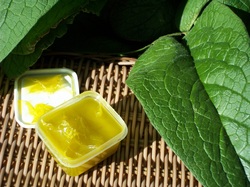
We had hardly any bruises, breaks, road rash, strains, or sprains in the next decade, so that's how long I kept the ointment. It seemed to still work well at the end there, though the sooner you use it, the more potent it is. The next batch (same size!) lasted us only about 18 months; one son had FOUR broken bones within a year (trampoline, trampoline, trampoline, and scooter). Glad that's over (knock on wood...)! When he broke both his ankles simultaneously, I rubbed comfrey ointment on them twice a day. The doctor was amazed at the healing by his two-week checkup.
I crushed my ring finger between two weights; it turned purple clear down to my wrist. I splinted it with a popsicle stick and put comfrey on it once or twice a day (depending on how often I remembered!). The nail had threatened to fall off, but it didn't, and it grew back straight and smooth. The finger was almost completely healed in two to three weeks. And I don't heal very quickly.
An ointment doesn't blend into your skin, but forms a layer over it. It's especially good for places where the skin is weak, or where you need a barrier from moisture (like in diaper rash). You could make this with coconut oil, which is solid at less than 75 degrees F, instead of petroleum jelly, but that's closer to the definition of a cream since that version will more easily soak into the skin.
Use any herb you want.
You can use the same amount of oil instead of the petroleum jelly, but that's called an 'infusion' instead of 'ointment'. (For a cold infusion, see bottom of page.) Old-timers used lard or other animal fats as the base; I'll try coconut oil for my next batch. It's supposed to have healing qualities itself.
Comfrey Ointment
16 oz/2cups petroleum jelly (like Vaseline) -or coconut oil
2 oz. dried herb (or 500 g petroleum jelly, 60 g dried herb)
Melt jelly in double boiler, stir in herbs, heat gently for a couple hours (2-3)until herbs become crisp. Strain through cheesecloth or muslin, squeeze to get as much liquid out as possible. Be careful and/or use gloves, the mixture is very hot. Pour while hot into clean storage containers. Best if used within a year. Good for arthritis, broken bones, bruises, inflamed bunions, torn ligaments, etc.
Comfrey's "country name" was "knitbone". It contains allantoin; this encourages cell growth in bone, cartilage, and muscle. My experience is that it heals skin, too. Use the above-ground parts; the leaves and flowers have the most allantoin.
You can mash/crush the leaves to make a poultice for broken bones, including ribs and hairline fractures. My book says the powdered root, mixed with water to make a paste, is good for varicose ulcers, stubborn wounds, and bleeding hemorrhoids. I haven't needed that remedy yet. :-) Best to harvest the root in spring or fall, when the plant is putting its energy into its roots. ( As a side note, yes, this is correct grammar in “its roots”; there is no apostrophe in a possessive “it”. I’ve been seeing “it’s” so much lately I was wondering if I learned the wrong rules. Here’s my proof of what’s correct, a webpage called It’s “its”! )
A related remedy is for burns: mix equal amounts honey (raw, if you have it) and olive oil. Chop or mash comfrey; add enough to the honey/oil to make a paste. Apply to burns; wrap loosely with gauze or lightweight cotton so it stays put. Put it on as needed. I used this when a red-hot coal landed on my bare foot one day last summer. I put the paste on, and promptly forgot about it. When I remembered later in the evening, all that remained was a slight red mark. No blister, no pain.
For a "cold infusion", to extract the plant's helpful compounds without cooking it, pack a quart jar full of the herb you want. Pour two cups of oil (olive oil, sunflower oil are better choices) over it, screw a lid on, and let it sit on a sunny windowsill for two or three weeks. Strain into clean bottles, amber-colored ones are helpful in protecting it from damage from the light. Store it cool and dark.
 RSS Feed
RSS Feed